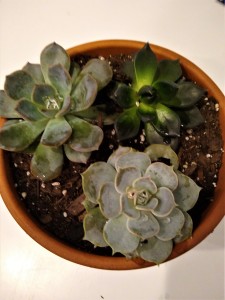 Succulents, especially the rose-form echeverias, have been in vogue for the last fifteen years. They have flirted with the public in botanical institutions, teased onlookers from the tops of show house coffee tables, and beguiled shoppers in garden centers. Sometimes, especially in winter, they seem to be everywhere.
Succulents, especially the rose-form echeverias, have been in vogue for the last fifteen years. They have flirted with the public in botanical institutions, teased onlookers from the tops of show house coffee tables, and beguiled shoppers in garden centers. Sometimes, especially in winter, they seem to be everywhere.
Though I am prone to falling in love with plants at the drop of the hat, I have never succumbed to succulents in general or echeveria in particular. Though they are easy on the eyes and available in a wide range of colors and forms, I have always thought that growing succulents is about as exciting as watching paint dry.
Now I am reconsidering that assessment—all because of a serendipitous incident.
One day, as I was doing research for an article on house plants with pink leaves, I happened on pictures of Echeveria ‘Rainbow’, a six-inch-wide hybrid plant with plump, fleshy leaves that combine stripes of soft pink, muted cream, and gray-green. It was gorgeous, with a perfect rosette form and rounded, slightly pointed leaves. I felt my heart flutter, but the flutter turned to arrhythmia when I saw that a single ‘Rainbow’ would cost upwards of thirty dollars. Clearly the budding romance was too young for that kind of expenditure.
I did a bit more research and found that ‘Rainbow’ is a variegated offspring of one of the most popular echeveria varieties, ‘Perle von Nurnberg’, or ‘Pearl of Nuremberg’ in English. The parent has the same perfect rosette form, but the petals are gray-green with lighter edges and pinkish-purple overtones. More to the point, it is available for considerably less money than its flashy child.
I decided to give the whole matter additional thought.
In the midst of that thought process, I went to the garden center to get the makings of an Advent wreath. Having recently gone on a spree at the same establishment, I planned on leaving with a plain wreath and four candles.
After I crossed the threshold of the garden center, a funny thing happened on the way to the candle display. I was confronted by scores of echeveria. I had to stop and look.
The echeveria lined up in the garden center trays came in two pot sizes, four-inch and two-inch. The varieties were not named, but there were at least ten different types. All were rosette-form, but some had rounded leaves, while others bore distinctly pointed foliage. The leaf colors ranged from near-black, to shades of brighter and darker green, to gray-green. The gray-green echeveria leaves also appeared glaucous, as if each leaf was covered with a powdery translucent veil. Some of the plants’ leaves had reddish or pinkish overtones, making them similar to ‘Perle von Nurnberg’.
The price markers on the little pots indicated that I could buy three of the larger or smaller varieties for a single, reasonable price. Without the pressure of trying to decide whether my new interest in echeveria was worth laying out over thirty dollars, I made up my mind quickly. I bought three of the two-inch pots, each with a different echeveria. At home I planted them in a terra cotta pot filled with cactus potting mix and set them in a sunny, south-facing window. They look lovely, even if they are not as spectacular as ‘Rainbow’.
Like the jade plants that many of us harbor on our windowsills, echeveria is a member of the Crassulaceae family. The rosette-forming plants are native to the New World and hail originally from Mexico and parts of Central and South America. They require lots of sunshine, very little water and free-draining soil. In the summer, I will take mine outside to bask in the sunshine. If I am very lucky and the plants are very happy, they may flower or even produce offsets, which can be grown on into new plants.
Even if my echeveria end up being as static as I always assumed, the small investment has provided me with something pretty and undemanding. If echeveria grows on me—figuratively speaking—I can contemplate purchasing ‘Rainbow’ without feeling guilty.
If you feel a sudden yen for echeveria, the plants are now in stock at many local nurseries and garden centers. You can pick up a few when you go to buy holiday decorations. For a selection of named varieties, go to Mountain Crest Gardens, 402 Bridge St., Fort Jones, CA 96032; (877 656-4035; www.mountaincrestgardens.com.
